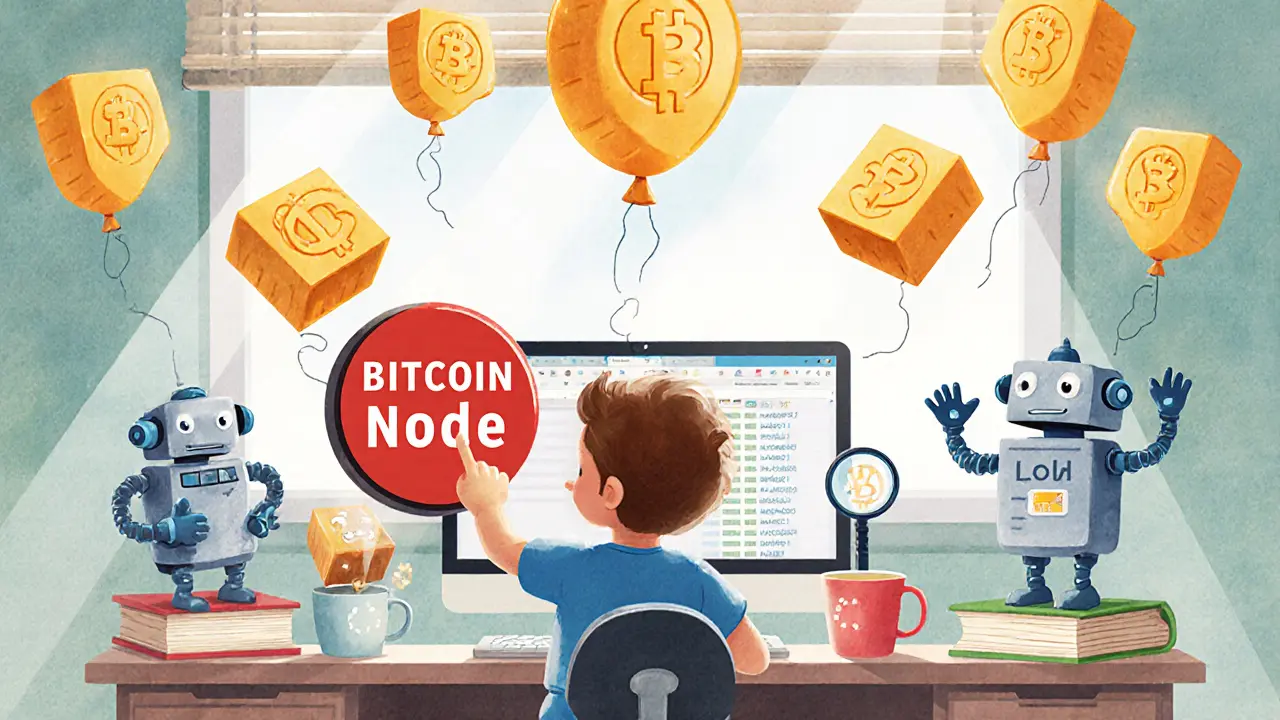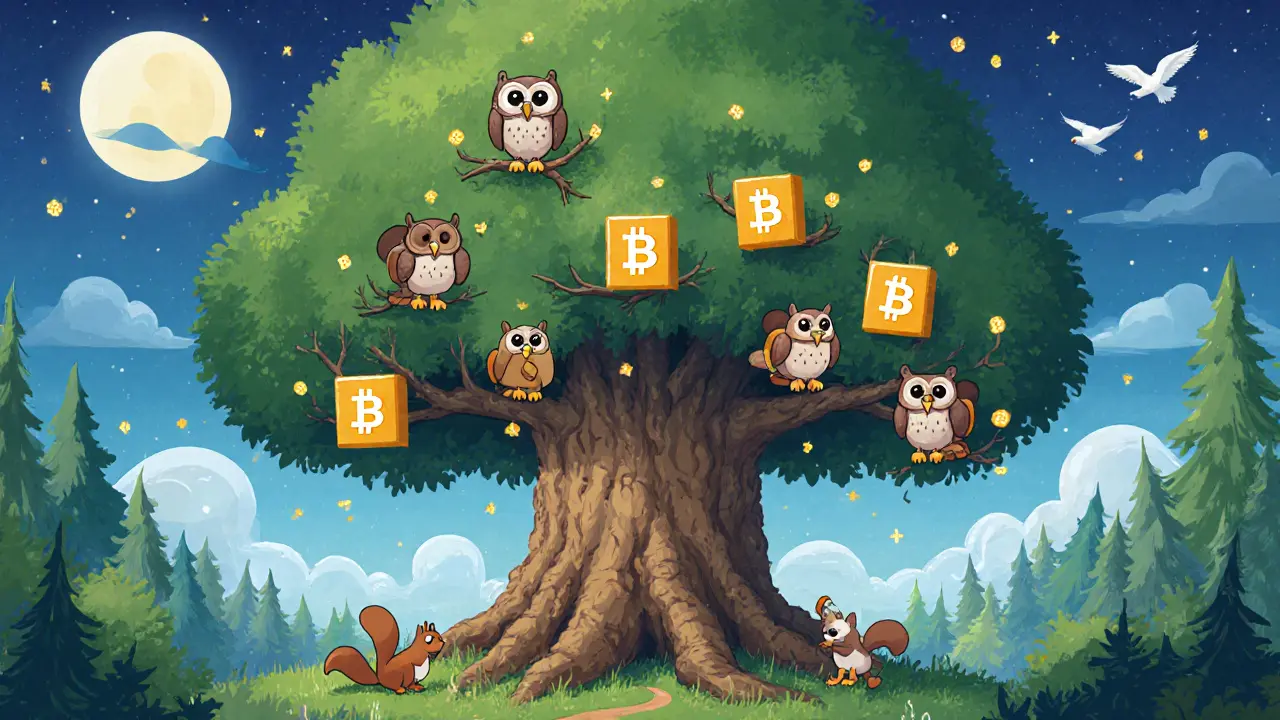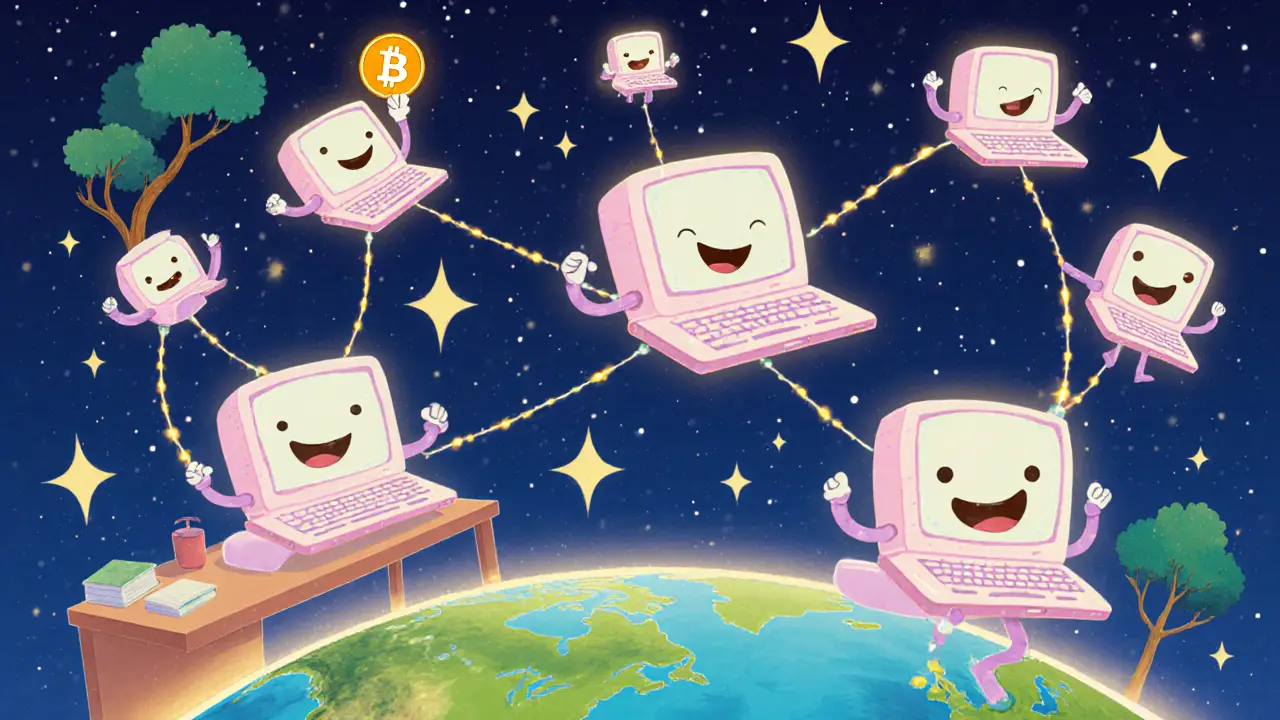Bitcoin Node Requirements Estimator
Estimate whether your device can run a Bitcoin node based on current blockchain size and your internet connection.
Current Network Requirements (2025)
Calculate Your Node Requirements
Results
Enter your internet speed and storage capacity to see if you can run a Bitcoin node.
Bitcoin doesn’t run on servers owned by banks, tech companies, or governments. There’s no central computer controlling it. Instead, it runs on a global network of regular computers - yours, mine, and thousands of others - all talking directly to each other. This is the Bitcoin P2P network, and it’s what makes Bitcoin truly unique. No middlemen. No single point of failure. Just machines working together to keep the system alive.
What Exactly Is a P2P Network?
Think of it like sharing music files back in the early 2000s with Napster or BitTorrent. Instead of downloading a song from one central server, you grab pieces from multiple people who already have it. Bitcoin works the same way - but instead of songs, it’s sharing blocks of transactions.
In Bitcoin’s case, every participant - called a node - is both a client and a server. That means every node can send and receive data. There’s no boss node. No headquarters. If one node goes offline, the others keep going. The network doesn’t care. It just keeps running.
How Do Nodes Find Each Other?
When you install Bitcoin Core and turn it on, how does your computer know who to talk to? It doesn’t have a phonebook. It doesn’t ask a central server for a list. Instead, it uses a clever mix of built-in tricks.
First, it checks nine different DNS seed servers. These aren’t owned by one company - they’re run by different people around the world. Each one returns a random list of active Bitcoin nodes. If one server is down, the others still work. It’s like having nine different friends who each give you a list of party guests - even if two of them forget to show up, you still get enough names to find the party.
If the DNS seeds fail (which is rare), Bitcoin falls back to a list of hard-coded IP addresses built into the software. These are known as seed nodes. They’re public, reliable, and maintained by trusted developers. You don’t need to trust them - you just use them as a starting point. Once you connect to one, you start getting lists from other nodes, and soon you’re talking to dozens.
For extra privacy, some users connect through Tor or I2P. These tools hide your real IP address, making it harder for anyone to track which nodes you’re talking to. It’s not required, but it adds a layer of anonymity - something the original Bitcoin design always valued.
What Do Nodes Actually Do?
Not all nodes are the same. There are two main types: full nodes and pruned nodes.
Full nodes download and verify every single block and transaction since Bitcoin’s beginning. That’s over 500 gigabytes of data as of 2025. They check every rule: Is this transaction valid? Did the sender really own these coins? Is the math behind the signature correct? They don’t just accept what others say - they prove it themselves. These are the guardians of Bitcoin’s rules.
Pruned nodes do the same validation but don’t keep the whole blockchain forever. After they verify a block, they delete the old data - keeping only the most recent parts. They still enforce all the rules, but they save storage space. This makes running a node easier for people with smaller hard drives.
Then there are SPV nodes - Simplified Payment Verification. These are lightweight wallets you might use on your phone. They don’t download the whole blockchain. Instead, they ask full nodes for proof that a transaction is included in a block. They’re faster and use less data, but they rely on others to be honest. You’re trusting someone else’s word, which is less secure than running your own full node.

How Transactions Spread Across the Network
When you send Bitcoin, your wallet doesn’t blast it out to everyone at once. It sends the transaction to one or two connected nodes. Those nodes check it - same rules as before: valid signature? enough fees? not already spent? If it passes, they pass it on to their own connections. Soon, it’s spreading like a chain reaction.
It usually takes just seconds for a transaction to reach most of the network. But it doesn’t become official until it’s included in a block - and that’s where mining comes in. Miners collect dozens or hundreds of transactions, bundle them into a block, and compete to solve a hard math puzzle. The first one to solve it gets to add the block to the chain.
Once a block is added, it’s broadcast across the network. Every full node checks it again - is the math right? Are all the transactions inside valid? If yes, they accept it. If not, they reject it. This is how the network stays honest. No one can cheat the system unless they control more than half the network’s computing power - and even then, they can’t steal coins. They can only delay or block transactions.
Why This Design Is So Powerful
Traditional banking systems rely on central servers. If Visa’s servers go down, payments stop. If a bank’s database is hacked, your money could vanish. Bitcoin has no such single point of failure.
Even if 90% of the nodes disappeared overnight, the remaining 10% would still keep the network running. The blockchain is copied everywhere. The rules are enforced by code, not by people. And because every node validates everything, no one can change the rules without everyone else agreeing.
This is why governments can’t shut Bitcoin down. You can block access to websites. You can ban exchanges. But you can’t stop millions of computers from talking to each other. You can’t unplug the entire internet. And that’s the point.

What It Takes to Run a Node
Running your own full node isn’t hard - but it does require some resources.
- Storage: At least 500 GB of free space (and growing). The blockchain adds about 50 GB per year.
- Bandwidth: Around 5-10 GB per day, depending on network activity.
- Time: The initial sync can take anywhere from 12 hours to several days, depending on your internet speed and hardware.
- Hardware: A modern computer with a decent CPU and SSD will make the process much faster. A Raspberry Pi can run one, but it’ll be slow.
Most people don’t run full nodes because they don’t realize how easy it is - or they think they need to be tech experts. But Bitcoin Core’s interface is straightforward. You download it, click install, and let it sync. You don’t need to understand the code to benefit from it.
And here’s the real win: when you run your own node, you don’t have to trust anyone. You verify your own transactions. You know your coins are safe. You’re not relying on a third-party wallet app that could freeze your funds or disappear tomorrow.
What’s Next for the Network?
The Bitcoin P2P network isn’t frozen in time. Developers keep improving it. Recent updates like Taproot and Dandelion++ make transactions more private and efficient. Dandelion++, for example, hides where a transaction came from by bouncing it through a few random nodes before broadcasting it widely. That makes it harder for observers to track who sent what.
There’s also ongoing work to reduce bandwidth use and make syncing faster. The goal isn’t to make Bitcoin bigger - it’s to make it more resilient, private, and accessible.
Meanwhile, second-layer solutions like the Lightning Network handle small, fast payments off-chain, reducing pressure on the main network. But even Lightning relies on the same P2P foundation. It’s built on top of Bitcoin’s decentralized backbone.
Why This Matters
Bitcoin’s P2P network isn’t just a technical curiosity. It’s a new kind of infrastructure - one that doesn’t need permission to exist. It works without CEOs, without regulators, without banks. It’s maintained by people who believe in open systems, privacy, and self-sovereignty.
For the first time in history, you can send money directly to someone on the other side of the world without asking anyone for approval. No fees from intermediaries. No delays from bureaucracy. Just code, cryptography, and a global network of strangers who all agree on the same rules.
That’s not just innovation. It’s a revolution.

19 Comments
Genevieve Rachal
November 2, 2025 AT 00:12 AMLet me be real for a second - if you think this P2P thing is some revolutionary breakthrough, you’ve been living under a rock since 2012. Every decentralized system ever built collapses when it hits scale. Bitcoin’s just a glorified peer-to-peer file share with extra steps and way too much hype. The fact that people still run full nodes is cute, like keeping a fax machine in your garage because ‘it’s authentic.’
Eli PINEDA
November 3, 2025 AT 13:26 PMwait so nodes are like… people’s laptops just chillin and relaying txs? no server? that’s wild. i thought bitcoin was all miners and wallets. so my computer is part of the network if i download the app? 🤯
Debby Ananda
November 4, 2025 AT 04:24 AMOh honey, you’re so sweet for thinking this is ‘simple.’ 😏 The P2P network? It’s a Byzantine fault-tolerant distributed ledger protocol wrapped in a crypto-anarchist fantasy. You think your Raspberry Pi is ‘helping’? You’re just a noisy echo in a sea of ASICs and Tor relays. #BitcoinIsNotForYou
Malinda Black
November 4, 2025 AT 12:27 PMHey, if you’ve ever wondered how to get started with a node - you don’t need to be a genius. I ran mine on an old laptop with a 1TB drive, and it synced over a weekend. Just download Bitcoin Core, let it run, and maybe leave it on overnight. It’s not magic - it’s just code doing its job. You’re not ‘saving’ Bitcoin, but you’re definitely helping it stay alive. And that’s more than most people do. 💪
Eliane Karp Toledo
November 4, 2025 AT 19:09 PMDNS seeds? Hard-coded IPs? HA. You think that’s decentralized? Nah. Those ‘trusted developers’ are just CIA frontmen. The whole thing’s a honeypot. They let you sync, then they feed you fake blocks to track your location. Tor? That’s just a backdoor with a fancy name. The real power? The NSA owns the mining pools. Bitcoin’s not decentralized - it’s a psyop to distract you from the real digital currency: CBDCs.
Bhavna Suri
November 6, 2025 AT 18:38 PMThis is too much. Why do people care about nodes? Just use Coinbase. It works. Why make it complicated?
Elizabeth Melendez
November 7, 2025 AT 22:23 PMOkay so I just set up my first full node last week and honestly? It’s kind of beautiful. I didn’t know what I was doing, but I clicked ‘install’ and walked away for 18 hours. Came back and it was synced. No ads, no login, no ‘upgrade to pro.’ Just pure, unfiltered blockchain. I’ve never felt more in control of my money. And yeah, it takes space - but your phone has 256GB and you still take 200 selfies. Priorities, people. 🙃
Phil Higgins
November 8, 2025 AT 21:01 PMWhat’s being overlooked here is the philosophical weight of this architecture. It’s not merely technical - it’s ontological. The network doesn’t ‘trust’ nodes; it verifies them. Each validation is an act of epistemic autonomy. This isn’t finance. It’s a social contract written in SHA-256. The state can ban exchanges, but it cannot unilaterally invalidate a proof-of-work consensus. That’s power. That’s dignity.
Kymberley Sant
November 9, 2025 AT 17:05 PMWait so SPV nodes are basically trusting strangers? LOL no thanks. I saw a guy on Twitter say his phone wallet got hacked because ‘it trusted a node’ - and he lost 0.5 BTC. Duh. If you’re not running your own node you’re basically handing your keys to a stranger at a bus stop. And don’t even get me started on lightning - that’s just a centralized bank with extra hops.
Edgerton Trowbridge
November 10, 2025 AT 06:14 AMThe operational requirements for running a full node are often underestimated. While the software is accessible, the bandwidth and storage demands represent a non-trivial barrier to entry for individuals in regions with limited infrastructure. Furthermore, the initial synchronization process can strain consumer-grade hardware, potentially leading to premature device degradation. These factors must be weighed against the perceived benefits of self-custody.
Matthew Affrunti
November 12, 2025 AT 00:29 AMJust ran my node for the first time and it felt like I was part of something real. No middlemen. No ‘customer service.’ Just me and the blockchain. If you’ve never tried it, do it. It’s free. It’s easy. And honestly? It changes how you see money. No hype. Just code. 🚀
mark Hayes
November 12, 2025 AT 01:15 AMso like… if my node goes offline for a day does the network care? lol i just turned off my pc last night and woke up to my coffee and my node still syncing. feels like a quiet little robot doing its thing. 🤖💙
Derek Hardman
November 12, 2025 AT 22:00 PMThe elegance of this system lies not in its complexity, but in its resilience. It does not require consensus among participants - only verification. This is a fundamental shift from hierarchical trust to algorithmic trust. The implications extend beyond currency into governance, identity, and infrastructure. We are witnessing the birth of a new class of public good.
alvin Bachtiar
November 14, 2025 AT 07:39 AMLet’s be honest - 99% of nodes are just bots, VPSs, or mining rigs masquerading as ‘individuals.’ The real P2P network? It’s dominated by institutional actors with custom firmware and BGP hijacks. You think your home PC is ‘decentralizing’ Bitcoin? You’re a drop in the ocean. The real decentralization is in the code. The rest? Theater. And don’t even get me started on Dandelion++ - it’s just obfuscation for the rich who can afford Tor.
Josh Serum
November 14, 2025 AT 22:59 PMPeople who run nodes are the only ones who actually understand Bitcoin. Everyone else is just gambling with someone else’s ledger. If you’re using a wallet app that doesn’t let you verify your own transactions, you’re not owning Bitcoin - you’re renting it. And rent is slavery. You’re just a tenant in someone else’s empire. Wake up.
DeeDee Kallam
November 15, 2025 AT 00:43 AMi just spent 3 days syncing and now my laptop is slow and my internet is slow and i feel like i wasted my life. why did i do this. why. why. why.
Helen Hardman
November 15, 2025 AT 23:14 PMY’all are overcomplicating this. I run a node because I hate banks. I hate that they can freeze my money. I hate that they charge me $5 to send $100 to my cousin. This? This is freedom. I don’t need to understand the math. I just need to know it works. And it does. My node synced. My money’s safe. I’m happy. That’s all that matters. 💖
Vicki Fletcher
November 17, 2025 AT 10:20 AMWait - so if a node rejects a block, does that mean the whole network stops? Or does it just ignore that one? And what if the majority of nodes are lying? Can’t they just lie to each other and create a fake chain? I mean… what’s stopping them? There’s no ‘truth police’ here… right?
alvin Bachtiar
November 18, 2025 AT 17:01 PM^ This is exactly why SPV wallets are dangerous. You think you’re ‘using Bitcoin’ - but you’re just using a proxy that could be lying to you right now. I’ve seen wallets that show ‘confirmed’ transactions that never made it to the chain. Your phone doesn’t verify - it trusts. And trust is the enemy of security.